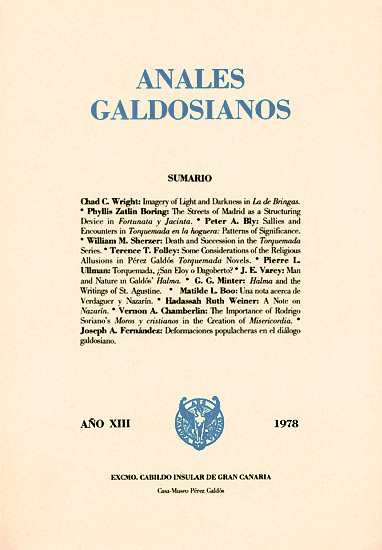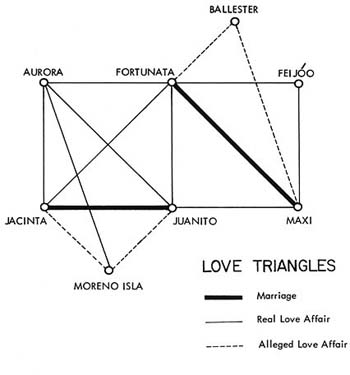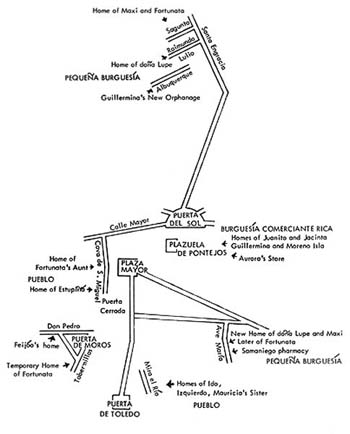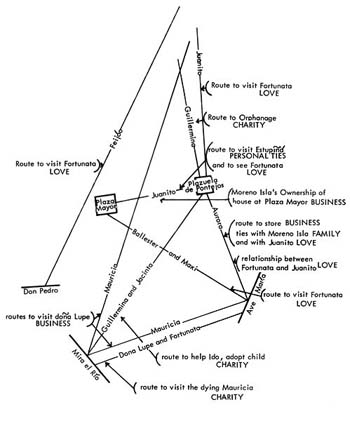—11→ —12→ —13→
In the four parts of his longest and greatest novel, Fortunata y Jacinta, Benito Pérez Galdós introduces dozens of characters and describes in extensive detail the history and background of Madrid. The result is «a world of interlaced streets, professions, and classes, perhaps the most complex world ever to be constructed within the frontiers of a single book».23 That world is of primary importance to our understanding of the novel and cannot be disregarded; as Carlos Blanco-Aguinaga has carefully noted, Galdós has taken great pains in pointing out for us exactly where his characters live and how, in the case of Fortunata, their moves indicate changes in social status.24 The novel may be, as the author himself labelled it, «Dos historias de casadas», but it is also the novel of Madrid: «El lector de Fortunata y Jacinta tiene la suerte de encontrarse con la descripción del paisaje físico de Madrid -admitida su elaboración artística- y además con una serie de relaciones individuales e interacciones sociales que le procuran el conocimiento del discurrir diario de la vida en Madrid.»25 Galdós' purpose in describing the interlaced streets of the city is not merely to provide us with a map against which the action occurs but to show us the interaction between characters and to emphasize how their paths cross. «El ambiente galdosiano no es más ni menos que la compleja relación, o interdependencia, de los personajes; y ésta, sin duda, es la mejor clave para comprender el arte de novelar de Galdós».26 In some respects Fortunata y Jacinta anticipates the multiple protagonist novels of the 20th century in which the authors indicate that the lives of their many characters are intertwined, novels such as Dos Passos' Manhattan Transfer, Huxley's Point Counterpoint, Veríssimo's Caminhos cruzados, Valle-Inclán's El ruedo ibérico, or Cela's La colmena.
Perhaps because of the complexity of Fortunata y Jacinta, critics have frequently attempted to provide a structural explanation for the framework of the novel. Notable among these analyses are two provided by Ricardo Gullón. At different points in time he has discussed the novel as a description of three worlds -los comerciantes, la pequeña burguesía, and el pueblo- united by two forces, love, as personified by Fortunata, and charity, as personified by Guillermina,27 and as a novel based on four triángulos cambiantes in which Fortunata is always present as one of the figures in the romantic conflict and in which Guillermina and Mauricia la Dura represent opposite poles of good and evil.28 While both of these analyses are true as far as they go, neither adequately conveys the structural devices used by Galdós to hold together the elaborate world portrayed in his four-volumen novel. Teresa Silva Tena, in the introduction to her edition of Fortunata y Jacinta, asserts that there are more than fifteen main characters in the novel who are absolutely essential «para que las dos historias de casadas que Galdós nos cuenta fueran así y no de otra manera.»29 The links among these fifteen characters from the three social and economic worlds are much more complex than Gullón's simplification would indicate. (See Figure I) Not only is an interaction between —14→ —15→ —16→ the world established by love (Juanito and Fortunata's love affairs) and by charity (Guillermina's efforts to help the poor, aided often by Jacinta) but also by family ties (Aurora and Moreno Isla are related), by personal ties (Mauricia and her sister lived in Guillermina's home because their mother worked there), and by business (Mauricia sells merchandise for doña Lupe; Moreno Isla owns the house where Fortunata lives with her aunt). Moreover Fortunata, through her marriage to Maxi, and Estupiñá, through his relationship with the Santa Cruz family, effectively live with or belong to two of the worlds. Likewise the love triangles are more complicated than Gullón has suggested, in part because Jacinta, as well as Fortunata, forms part of a triangle when Juanito has an affair with Aurora and, in addition to the real love relationships that are established in the novel, there are also two alleged affairs -Fortunata with Ballester and Jacinta with Moreno Isla. (See Figure 2)
Figure 1
[page 14]
Figure 2
[page 15]
While the expanded diagrams of interrelationships between the three worlds and of love relationships do help to clarify the broad structural design of the novel, perhaps even more effective in showing Galdós' skillful interweaving of characters and story is an analysis of his use of the streets of Madrid itself as a structuring device. The three worlds are carefully located in different parts of the city; in some cases, the characters move from one section of the city to another, thus opening up new points of contact and new possibilities for interaction. On several occasions the forward motion of the plot is prompted by a chance encounter in the streets between two of the characters, encounters that can be carefully traced and explained by the geographical realities of the city. Not only are there fifteen or more characters essential to the development of the novel, as Silva Tena mentions, but it is likewise essential that some of these characters be prone to strolling the streets of Madrid and essential that some of them live next door to one another for the story to unfold as it does. The importance of the locale for the various characters and scenes has been partially noted by Blanco-Aguinaga (loc. cit.); that the streets themselves are firmly fixed in the consciousness and even subconsciousness of the characters is indicated not only by their relating anecdotes with exact street locations but by their dreaming of particular streets and remembering the precise locale of episodes from childhood.30
Although Galdós carefully outlines for us almost all of the streets of the commercial district near the Plaza Mayor and in the course of the novel mentions so many streets that to identify them all in a diagram would be to reproduce a detailed map of several sections of Madrid, one may in general say that the action of Fortunata y Jacinta revolves around several important locations: the Plazuela de Pontejos, near the Puerta del Sol, where upper middle-class characters live; the Cava de San Miguel and adjacent Plaza Mayor, where some of the cuarto estado live; the area near the Puerta de Toledo, particularly Mira el Río, where others of the poor live; the quiet and relatively isolated area on the other side of the Puerta Cerrada where Feijóo lives and where he maintains Fortunata during their love affair; the area of Chamberí where doña Lupe lives, an area we initially identify with the lower middle-class; and Ave María, near the Plaza Lavapiés, where doña Lupe moves so that Maxi can be close to the pharmacy where he works. (See Figure 3.) Onto this schematic map of Madrid we can superimpose a diagram similar to Figure 2 in which we show the relationships between individual characters, and, in fact, in many instances the novel simply would not have been the —17→ —18→ —19→ —20→ same if characters had not gone to certain places at certain times. (See Figure 4) For example, Juanito first meets Fortunata because he has gone to the Plaza Mayor to visit Estupiñá. Doña Lupe has partially developed her desire to know and associate with Guillermina because she sees her pass by daily en route to her new orphanage on Albuquerque. The Feijóo-Fortunata relationship is kept secret because their meeting place is out of the areas of the city where they are likely to be seen. The Juanito-Fortunata relationship had earlier been discovered because Santa Engracia was a main thoroughfare. Jacinta meets Izquierdo and Juanito's alleged illegitimate son because Izquierdo is a neighbor of Ido, whom she has gone to visit on a mission of charity. Fortunata becomes as involved as she does with Ballester and with Aurora because she and Maxi live so close to the Samaniego pharmacy after the move from Chamberí; the third of her affairs with Juanito is prompted by a chance encounter that likewise might not have occurred had she still lived in Chamberí. Aurora becomes involved with Juanito because her store is located next door to his house on the Plazuela de Pontejos. Doña Lupe and Fortunata become aware of Mauricia la Dura's collapse as readily as they do because she falls within sight of their window. Given the length and complexity of the novel, there are numerous examples possible of this kind of linking of story with city streets.
Figure 3
[page 17]
Figure 4
[page 18]
Figure 5
[page 19]
To show Galdós' skillful use of the streets of Madrid as a structuring device, let us examine in greater detail two episodes in particular that greatly affect the development of plot: the chance meeting of Feijóo and Fortunata, which precipitates their relationship, and Maxi's chance discovery that Aurora is now Juanito's mistress.
When Fortunata is abandoned by Juanito the second time, she sets out through the streets of Madrid to go to his house. Her movement through the streets is carefully described by Galdós (p. 337). She watches Juanito leave his home, and then retraces her steps, arriving at the Puerta del Sol, then and now a crossroads in Madrid. She is discovered there by Feijóo. While anyone who knows Madrid is willing to accept a chance encounter there as well within the realm of possibility, Galdós has actually carefully prepared this meeting in his previous description of Feijóo's habit of joining the same tertulia as Juan Pablo Rubín in now one café, now another. Following Juan Pablo, Feijóo had shifted first to a café on the Calle Mayor (p. 315) and then to one on Fuencarral (p. 317). The change is significant. Were Feijóo returning home from the Calle Mayor, there would be no need to pass through the Puerta del Sol. From Fuencarral, however, this is his logical path. (See Figure 5)
Similarly there is careful preparation for Maxi's discovery of the relationship between Aurora and Juanito, information which he uses in such a way that he indirectly causes Fortunata's death. Following his second separation from Fortunata, Maxi had begun participating in Juan Pablo's tertulia. Significantly, Juan Pablo had shifted cafés again, this time choosing one at the Plaza Mayor; had he remained at his previous choice on the Plaza Antón Martín, the stage would not have been set for the end of the novel. Because Fortunata has now returned to her starting point, she is able to see Maxi pass by in the Plaza Mayor from her window and he, seeing Izquierdo take his niece's shoes for repair, can deduce where Fortunata lives. Also because Maxi now lives on Ave María, not Raimundo Lulio, his path home from the Plaza Mayor logically takes him near Aurora's shop. His assumption —21→ —22→ when he sees her leaving the store is that she will walk the same way he usually does to their neighboring homes, but instead he sees her meet Juanito and then follow a darker, more circuitous route home (pp. 514-15). It is a path that Galdós allows us to follow as well. (See Figure 6)
Figure 6
[page 21]
The fictional world of Galdós in Fortunata y Jacinta is a highly complex one, built on the interlacing of relationships between many characters, both major and minor. To lend unity and credibility to this world as well as to underscore the ties that exist between individuals and social classes Galdós skillfully uses the network of Madrid's streets as a structuring device underlying the action of his novel.
Rutgers-The State University New Brunswick, N. J.





